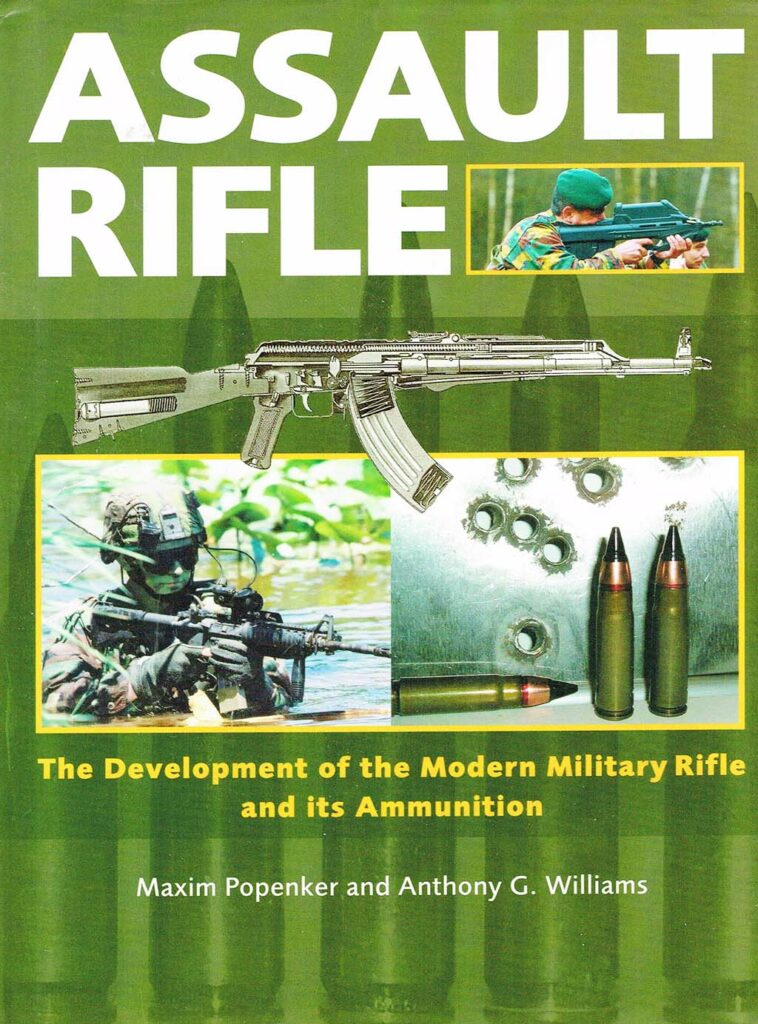BY DEAN ROXBY

Anyone interested in the history, development, selection and use of modern military rifles will find this book to be a very useful reference source. Assault Rifles covers all aspects of the infantry rifle design, from its first inception, to its current state and to future trends.
This book is the collaboration between authors Maxim Popenker and Anthony Williams. Mr. Popenker, a Russia-based author, is the owner of the excellent website, Modern Firearms. Mr. Williams, from the U.K., also has his own site called Military Guns and Ammunition. This site focuses on current and older military ammo up to 57mm artillery-size rounds. Both authors have previously contributed articles to Small Arms Review.
Although the first gun to take the title “assault rifle,” or Sturmgewehr in German, was the StG 44, the authors make mention of a Russian design from the First World War. The Fedorov Avtomat of 1916 was the first to meet the accepted definition of a true assault rifle. Specifically, it must be capable of full-auto fire (usually selective fire), be magazine-fed and fire an “intermediate” power round. The cartridge used was the Japanese 6.5x50SR (semi-rimmed) Arisaka round. This seemingly odd choice of ammo came about due to capturing guns and ammo during the Russo-Japanese War of 1904–1905 and buying large amounts from Japan at the start of WWI. While very few Fedorovs were produced (~3000), they did see some action in the Russian Civil War (post-1917 Revolutions).
Assault Rifle is divided into two main sections. “Part I, Introduction,” starts with a look at the history of guns in battle, technical aspects of the various guns, as well as a very thorough study of assault rifle cartridges. The second section is a country-by-country study of the various guns in use, as well as experimental prototypes.
From a personal perspective, I found the first section to be the more interesting part, as it deals with the “nuts and bolts” of the design and development process. Part I details the progressive improvements of recent assault rifles, as well as some little-known, and sometimes unusual, experimental models. Procurement process shenanigans are mentioned as well. The portion on cartridge evolution and the ultimate selection by NATO members is most interesting. The authors detail the large volume of research that goes into designing the “perfect” cartridge.
A fine balance must be drawn between various factors when choosing a service round. Sufficient knockdown power, minimum recoil (in order to allow for controllable full-auto fire), high enough velocity to give a flat trajectory, heavy enough bullets to retain momentum at longer ranges and yet still be light enough to carry a sufficient number, etc., are all valid points to consider.
After much research by Britain, along with additional support from Belgium and Canada (“BBC committee”), the 7x43mm cartridge was submitted for NATO trials in 1950. However, good old-fashioned politics reared its ugly head at this point. The U.S. military decided to keep a .30-caliber bore diameter and simply shorten the venerable .30-06 service round slightly to create what would eventually become the 7.62x51mm NATO. The great flaw in this choice was that it was far too powerful to be fired from the shoulder in full-auto mode, meaning that the gun and ammo combo was outdated even before it was adopted.
Very soon after the adoption of the M14 and its 7.62×51 cartridge, the U.S. was once again looking for a true select-fire, intermediate-round assault rifle. The result was the famous M16 and its .223 Remington (5.56x45mm NATO) round. While the M16/5.56 combination fits the description of an assault rifle, there has been criticism of its lack of knockdown power.
Now, far too many years after the original British studies (from 1945 to 1951) which led to the 7×43 proposal, the U.S. military is testing the 6.8×43 Remington SPC (Special Purpose Cartridge). Although not identical, the 6.8×43 is suspiciously similar to the 7×43 round rejected so long ago. Part I, Chapter 4 covers this controversy in detail.
“Part II: The Weapons” deals with the guns. It is very encyclopedia-like, listing the entries on a country-by-country basis, first giving a rundown on the history and make-up of the country, then a more detailed look at the choice of arms. As Maxim Popenker is Russian, the entry for Russia and the former Soviet Union (USSR) is very thorough. Included are several prototypes entered in the trials that eventually led to the adoption of the AK-47. Several more types that competed in the Abakan (code-named after a city in Russia) trials of 1984 are also profiled, as well as a few others developed since then. One of the most unusual guns is the APS underwater assault rifle. The APS (Avtomat Podvodny Spetsialnyy), or special underwater automatic rifle, was developed for Navy Special Forces divers, and it truly can be fired under water! This unique gun uses a special 5.66x39mm MPS round with a 120mm-long, needle-type bullet. Also briefly mentioned is a newer updated version called the ASM-DT that can be used underwater with its special ammo or on land with standard 5.45×39 ammo. Clever!
It must be noted, this book is 15 years old, so it is missing the most recent designs. There is no mention of the Beretta ARX160, CZ 805 Bren, Fabryka Broni MSBS, HK416 or HK433, or the Kalashnikov Concern AK-12. Aside from that, this title covers the subject nicely. While not a large book, it does contain a lot of information.
Note: Since the publication of Assault Rifle, the two authors have joined forces again to publish two more books titled, Machine Gun: The Development of the Machine Gun from the Nineteenth Century to the Present Day and Sub-Machine Gun: The Development of Sub-Machine Guns and Their Ammunition from World War I to the Present Day. Unfortunately, these latter two books are no longer available from the publisher. Assault Rifle still is available, however.
Title: ASSAULT RIFLE: The Development of the Modern Military Rifle and Its Ammunition
Author: Maxim Popenker and Anthony G. Williams
ISBN: 1861267002 (print) / 978-1861267009 (website)
Copyright: 2004
Binding: Hardcover, with a color dust jacket
Size: 7.75 x 10 inches
Pages: 224; Color/B&W photos include 250 B&W photos
Publisher: The Crowood Press Ltd
| This article first appeared in Small Arms Review V25N3 (March 2021) |












